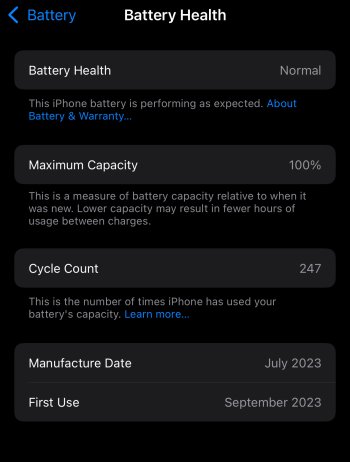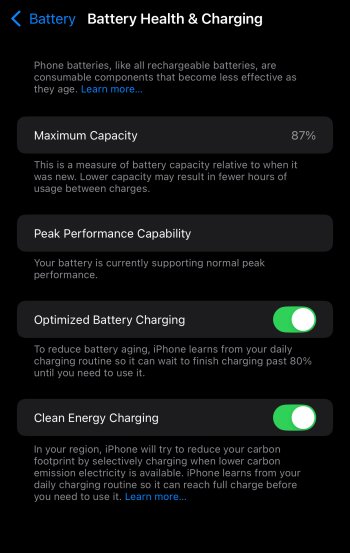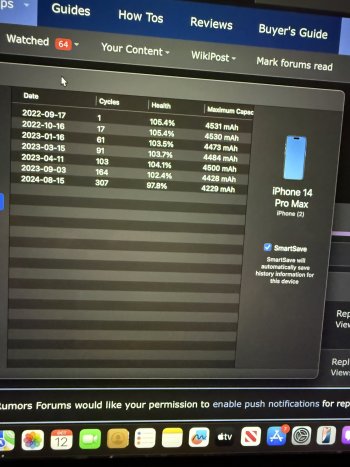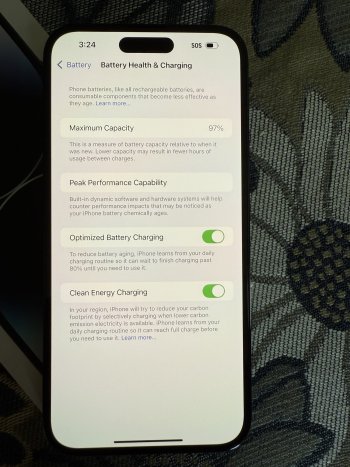Got a tip for us?
Let us know
Become a MacRumors Supporter for $50/year with no ads, ability to filter front page stories, and private forums.
iPhone 15 Pro MagSafe vs Wired
- Thread starter Andy_2341
- Start date
-
- Tags
- iphone mag safe charging
- Sort by reaction score
You are using an out of date browser. It may not display this or other websites correctly.
You should upgrade or use an alternative browser.
You should upgrade or use an alternative browser.
That version of MagSafe is what I would like to see replace the type-c in a few years. Simpler than an actual connector, and while I don’t own a Mac with one, I would guess easier to remove than the puck. Just go wireless for data transferMacBook's magsafe is the best because it is wired and magnetic best of both worlds.
Hope all other Apple products had this version along with the type C port.
What MagSafe charger were you using? 100% battery health after a year. I don’t think I’ve ever heard of that.I used MagSafe everyday on my former 15 Pro Max, had ~226 cycles and was at 100% battery health when I traded it in.
Matter of fact, I've used MagSafe since it was released alongside the 12 series. It didn't degrade my batteries at all.
Unfortunately, it won't happen unless the EU decides to standardize that connector. They mandated USB-C and took away the choice of using a proprietary connector, and I doubt Apple would want to make a USB-C version for the EU and a MagSafe version for everywhere else.That version of MagSafe is what I would like to see replace the type-c in a few years. Simpler than an actual connector, and while I don’t own a Mac with one, I would guess easier to remove than the puck. Just go wireless for data transfer
True. Maybe a variation of Qi or a new universal standard that follows the same general concept of Mac MagSafe but optimized for phones and tablets?Unfortunately, it won't happen unless the EU decides to standardize that connector. They mandated USB-C and took away the choice of using a proprietary connector, and I doubt Apple would want to make a USB-C version for the EU and a MagSafe version for everywhere else.
Low amp wired only and 80% limit.
15 Pro before I sold it

Unlike other claims of 100% at trade-in, I have a screenshot of my device before I sold it to a friend. It has since dropped to 99% (from what he tells me) but still quite decent considering this device had heavy use (depleted battery) multiple times when covering events, editing 4K video from itself and an EOS R5, as well as batch photo processing.
I deal with massive Lithium ion battery banks for our critical infrastructure at work (2 Megawatt UPS systems for Datacenters). There is a science to keeping battery health, heat, fast charging, fast (high amp) discharges will hurt longevity. It is why companies like Toshiba, Samsung and others have BMS (Battery Monitoring Systems) in all installs.
I have no doubts that my using industry recommended procedures has helped my overall battery longevity. But I am an edge case that keeps / collects devices. ( I still have a 15gb 3rd generation iPod with original battery)
My 2018 Xs Max with original battery that was purchased by me new, then handed down to my Mother who just recently was upgraded to a 15 Pro Max. She also only charged it with a legacy small USB-A iPhone charger.

15 Pro before I sold it

Unlike other claims of 100% at trade-in, I have a screenshot of my device before I sold it to a friend. It has since dropped to 99% (from what he tells me) but still quite decent considering this device had heavy use (depleted battery) multiple times when covering events, editing 4K video from itself and an EOS R5, as well as batch photo processing.
I deal with massive Lithium ion battery banks for our critical infrastructure at work (2 Megawatt UPS systems for Datacenters). There is a science to keeping battery health, heat, fast charging, fast (high amp) discharges will hurt longevity. It is why companies like Toshiba, Samsung and others have BMS (Battery Monitoring Systems) in all installs.
I have no doubts that my using industry recommended procedures has helped my overall battery longevity. But I am an edge case that keeps / collects devices. ( I still have a 15gb 3rd generation iPod with original battery)
My 2018 Xs Max with original battery that was purchased by me new, then handed down to my Mother who just recently was upgraded to a 15 Pro Max. She also only charged it with a legacy small USB-A iPhone charger.

My own experience with MagSafe charging on my 13 pro max is that yes, it does affect battery health, probably because of the heat generated. On average, it was dropping about 1% per month, but somehow "magically" stayed at 81% until my AppleCare had expired (so no free battery replacement). 🤣I know this debate is as old as MagSafe itself probably, but I’m still curious. My dad and I both got identical iPhone 15 Pro’s in late July. I’ve primarily charge mine by wire with an 80% limit. He primarily charges his by MagSafe/Qi pads. I have 63 cycles and 98.82% battery health according to the analytics while his has 43 cycles and 98.82% health. I game on mine somewhat often and have only ever let the battery drop to 10% one time. He never games and places it on the pad whenever he sits down by it, so it usually has higher than 40% charge. I’m trying to figure out if there is a causation in the MagSafe pad and not a correlation because of his charging patterns.
Anyways, I ended up having my iPhone battery replaced at the end of the year (since I wasn't planning on upgrading), went back to charging over lightning, and its battery health just dropped to 96%. So far, wired charging does seem better for the battery, but it may also not matter to you if you upgrade often, or plan to just replace the battery eventually.
It's definitely a tad more inconvenient than docking it to my 3-in-1 Belkin MagSafe charger, but nothing I can't live with. 😊
My iPhone 14PM which I traded in two weeks ago had it since launch date showed 97% battery health. Only evidence I have is from coconut battery which was taken on 8/15 , one month before trade in and a photo of the iPhone 14PM on 9/22/24 showing 97% health.
Always charged it by wire to around 80% and no less than 40%.
PS. I have optimized charging and clean energy charging switches off. Only reason it was on was because the device was factory reset.
Always charged it by wire to around 80% and no less than 40%.
PS. I have optimized charging and clean energy charging switches off. Only reason it was on was because the device was factory reset.
Attachments
Low amp wired only and 80% limit.
15 Pro before I sold it
View attachment 2436294
Unlike other claims of 100% at trade-in, I have a screenshot of my device before I sold it to a friend. It has since dropped to 99% (from what he tells me) but still quite decent considering this device had heavy use (depleted battery) multiple times when covering events, editing 4K video from itself and an EOS R5, as well as batch photo processing.
I deal with massive Lithium ion battery banks for our critical infrastructure at work (2 Megawatt UPS systems for Datacenters). There is a science to keeping battery health, heat, fast charging, fast (high amp) discharges will hurt longevity. It is why companies like Toshiba, Samsung and others have BMS (Battery Monitoring Systems) in all installs.
I have no doubts that my using industry recommended procedures has helped my overall battery longevity. But I am an edge case that keeps / collects devices. ( I still have a 15gb 3rd generation iPod with original battery)
My 2018 Xs Max with original battery that was purchased by me new, then handed down to my Mother who just recently was upgraded to a 15 Pro Max. She also only charged it with a legacy small USB-A iPhone charger.
View attachment 2436295
So all you did was low amp wire and 80% limit? I don’t think most devices would retain 100% after 250 cycles just doing that.
My 14pro battery also hung on at 81% for almost 2 months. I ran it down a handful of times running 4k video at max brightness and that finally dropped it to 79% and into service status.My own experience with MagSafe charging on my 13 pro max is that yes, it does affect battery health, probably because of the heat generated. On average, it was dropping about 1% per month, but somehow "magically" stayed at 81% until my AppleCare had expired (so no free battery replacement). 🤣
Anyways, I ended up having my iPhone battery replaced at the end of the year (since I wasn't planning on upgrading), went back to charging over lightning, and its battery health just dropped to 96%. So far, wired charging does seem better for the battery, but it may also not matter to you if you upgrade often, or plan to just replace the battery eventually.
It's definitely a tad more inconvenient than docking it to my 3-in-1 Belkin MagSafe charger, but nothing I can't live with. 😊
Most of my phones have had 100% battery health after a year. 🤷🏼♂️What MagSafe charger were you using? 100% battery health after a year. I don’t think I’ve ever heard of that.
The HiRise 3 Deluxe.
That’s bizarre to me. I haven’t had one phone at 100% battery health after a year.Most of my phones have had 100% battery health after a year. 🤷🏼♂️
The HiRise 3 Deluxe.
It’s not always battery obsessed. Some people live in country where it’s not easy to get Apple’s official battery replacement, hence, for them, is worthwhile to keep the battery as long as possible.Obsessing over the battery health of my phone isn't something I'm interested in doing. I use it, and charge it when I need to - usually overnight on MagSafe. I use Optimized Charging, but no % limit. 95+% of my charging is done on MagSafe, but I'll use cables or power packs when I'm away from home/traveling, and top it off whenever I have the chance/feel the need.
My phones are usually around 79-80% battery health after 3 years, but at that point I'm ready to trade them in and upgrade anyways so I don't care. If I want to go beyond 3 years with it, I'll get a new battery put in it.
Just curious. Don’t you use case (so it dissipates heat during charging)?Just one data point: MagSafe since day one. 170 cycles; 100% health.
Last edited:
Checked the ”Do not care” option but at a higher level I do care; I don’t want to degrade my battery over normal, but I don’t think neither a wired or MagSafe option is doing that. As many pointed out, there’s no tangible proof of this.
I think MagSafe is a welcome addition of convenience to be used and have a 3-in-1 Belkin variant on the night table. So basically I just charge it when needed with best option available to me. wired or MagSafe.
To add to this, Apple just jacked up the charging effect of MagSafe for the 16 series, which has improved heat management, points to me that they are confident in the solution. The question of degrading battery health is probably, for every individual phone, more about other parameters then MagSafe charging or not.
I think MagSafe is a welcome addition of convenience to be used and have a 3-in-1 Belkin variant on the night table. So basically I just charge it when needed with best option available to me. wired or MagSafe.
To add to this, Apple just jacked up the charging effect of MagSafe for the 16 series, which has improved heat management, points to me that they are confident in the solution. The question of degrading battery health is probably, for every individual phone, more about other parameters then MagSafe charging or not.
I’ve found, in my anecdotal experience, that individual batteries vary and it has little to do with charging. My iPhone 6S never had a good battery and I charged it wired (obviously). My iPhone 11 Pro was charged on a Nomad wireless charger for about 18 months and seemed to have better battery than my 6S Plus after the same amount of time. I don’t stress and given I upgrade my phone every 1-2 years I tend to upgrade before battery becomes a problem.
Your experience is valid in the sense that the base chemistry between the two batteries are totally different. The 6S used Lithium cobalt (quite inferior), and the 11 used Lithium ion.I’ve found, in my anecdotal experience, that individual batteries vary and it has little to do with charging. My iPhone 6S never had a good battery and I charged it wired (obviously). My iPhone 11 Pro was charged on a Nomad wireless charger for about 18 months and seemed to have better battery than my 6S Plus after the same amount of time. I don’t stress and given I upgrade my phone every 1-2 years I tend to upgrade before battery becomes a problem.
For Lithium ion, the science for proper charging and battery maintenance is well studied. It is why (in Critical infrastructure and datacenters) Samsung will warranty batteries for 10 years when properly maintained. Toshiba with their SCIB technology will warrany fully for 12 years, limited warranty for 15 years.
Phone users will unlikely ever have a device for that long, so the more expensive SCIB tech will likely never see the light of day in a smartphone, but there is 100% factual science that proves slow charging, minimal heat, and minimizing discharge to have long term health.
Even the stingiest of iPhone users will use a phone no more than five years I’d say. That’s not nearly long enough to care about battery degradation based on what I’m seeing.Your experience is valid in the sense that the base chemistry between the two batteries are totally different. The 6S used Lithium cobalt (quite inferior), and the 11 used Lithium ion.
For Lithium ion, the science for proper charging and battery maintenance is well studied. It is why (in Critical infrastructure and datacenters) Samsung will warranty batteries for 10 years when properly maintained. Toshiba with their SCIB technology will warrany fully for 12 years, limited warranty for 15 years.
Phone users will unlikely ever have a device for that long, so the more expensive SCIB tech will likely never see the light of day in a smartphone, but there is 100% factual science that proves slow charging, minimal heat, and minimizing discharge to have long term health.
At 3 years, my 13 Pro was at 79% battery health but could still make it through the day for me most days. If I was going to hold onto it for another few years, I would've taken it in and gotten a new battery. I'd rather do that than spend every day I owned it obsessing over my battery health and charging habits.Even the stingiest of iPhone users will use a phone no more than five years I’d say. That’s not nearly long enough to care about battery degradation based on what I’m seeing.
Agree. I (and many others) would do that.If I was going to hold onto it for another few years, I would've taken it in and gotten a new battery.
Really?That’s not nearly long enough to care about battery degradation based on what I’m seeing.
5 years of use...assume you complete 250 full discharges per year...at 5 years that's 1250 charge-discharge cycles. Battery health will (more then likely based what I've read) be below 80%. We're talking 90-120min + less use compared to a new battery. Plenty of folks will notice and care if they're losing 90min+ of use from their phone...
If you're keeping a phone for 5 years (like I do), for the modest cost of changing the battery at around the 3 year mark it's worthwhile to increases the usability of the phone.
Well the good things is Apple made it easy not to obsess over the battery anymore for those that care. Simply set the charge limit and go.At 3 years, my 13 Pro was at 79% battery health but could still make it through the day for me most days. If I was going to hold onto it for another few years, I would've taken it in and gotten a new battery. I'd rather do that than spend every day I owned it obsessing over my battery health and charging habits.
Original owner, perhaps not. Their kids, their parents or spouses that get used phones and don't switch that often, for sure they get used that long or longer.Even the stingiest of iPhone users will use a phone no more than five years I’d say. That’s not nearly long enough to care about battery degradation based on what I’m seeing.
I know many HS age kids that (because they have other expensive hobbies) have iPhone 8, X, XS, and XR phones. The fact that these phones are supported by Apple so long (some of those I listed aren't anymore), makes battery health more important than many people in this thread don't consider (and clearly) don't care about.
That makes sense, I appreciate your knowledge on this one.Your experience is valid in the sense that the base chemistry between the two batteries are totally different. The 6S used Lithium cobalt (quite inferior), and the 11 used Lithium ion.
For Lithium ion, the science for proper charging and battery maintenance is well studied. It is why (in Critical infrastructure and datacenters) Samsung will warranty batteries for 10 years when properly maintained. Toshiba with their SCIB technology will warrany fully for 12 years, limited warranty for 15 years.
Phone users will unlikely ever have a device for that long, so the more expensive SCIB tech will likely never see the light of day in a smartphone, but there is 100% factual science that proves slow charging, minimal heat, and minimizing discharge to have long term health.
Probably the only forum Mod that I ever agree with 😂 ( joke )Original owner, perhaps not. Their kids, their parents or spouses that get used phones and don't switch that often, for sure they get used that long or longer.
I know many HS age kids that (because they have other expensive hobbies) have iPhone 8, X, XS, and XR phones. The fact that these phones are supported by Apple so long (some of those I listed aren't anymore), makes battery health more important than many people in this thread don't consider (and clearly) don't care about.
I was all hyped up about wireless charging until I read about the deleterious effects
on the battery. I keep iPhones for a long time before upgrading...my last phone was iPhoneX
and now I have a 16 Pro.
For me, battery longevity and health is top priority so Im sticking with a conventional
usb-c 20W charger. I have set my charge limit on my IP16 Pro at 80% and I top up when
it reaches 20%. So far so good...altho it's too early to tell if my approach is going to work.
on the battery. I keep iPhones for a long time before upgrading...my last phone was iPhoneX
and now I have a 16 Pro.
For me, battery longevity and health is top priority so Im sticking with a conventional
usb-c 20W charger. I have set my charge limit on my IP16 Pro at 80% and I top up when
it reaches 20%. So far so good...altho it's too early to tell if my approach is going to work.
Actually have two of them, one holds the phone up at 45 degree angle and has a micro usb socket Samsung EP-NG930 (either 5V 2A OR 9V1.67A) the other is flat and has a usb-c socket and does NOT work with a standard 5V usb adapter--Samsung ep-p3105 (9v/1.67A). Both seem to charge similarly. Since I have a plethora of micro usb cables I tend to use the EP-NG930 more.Do you have a model #/link? I have a heatsink cooler for my phone when I play games on it and always thought wireless chargers could use something like that too. I like the idea of it only kicking in when needed though.
Neither of these are current models--one was purchased at a garage sale for $0.50, the other at a thrift store for considerably more ($3.99).
Register on MacRumors! This sidebar will go away, and you'll see fewer ads.



